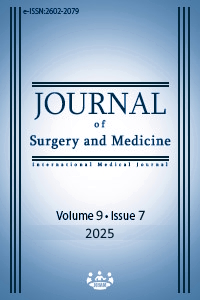The relationship of PAPP-A and ß-HCG values with fetal gender and fetal birth weight: A single-center experience
The relationship of PAPP-A and ß-HCG values with fetal gender and weight
Keywords:
Adverse pregnancy outcomes, Pregnancy associated plasma protein-A, B-HCG, dual testAbstract
Background/Aim: Intrauterine growth restriction (IUGR) is a multisystem disorder that results in perinatal morbidity and mortality due to decreased oxygen transfer from mother to fetus, a consequence of placental dysfunction. The placenta secretes certain unique proteins, the levels of which significantly rise in maternal blood during pregnancy. Among these, free beta-human chorionic gonadotropin (ß-HCG) and Pregnancy-Associated Plasma Protein-A (PAPP-A) are the most frequently analyzed. Our primary aim was to assess the correlation between PAPP-A and free ß-HCG levels, derived from the first-trimester dual-screening test, with fetal sex and birth weight. Our secondary aim was to determine the possibility of predicting IUGR using these markers.
Methods: The first-trimester screening data, along with fetal sex and birth weight, of singleton pregnancies in either primiparous or multiparous women who attended Istanbul Koşuyolu Medipol Hospital and gave birth during the first trimester, were retrospectively analyzed from the hospital file system.
Results: PAPP-A demonstrated a positive correlation with birth weight. It was significantly lower in cases of IUGR compared to normal fetal birth weight. A statistically significant correlation was also found between fetal gender and both ß-HCG and PAPP-A values; they were both higher in girls compared to boys (P<0.05).
Conclusions: Pregnancies with low PAPP-A values in first-trimester screenings should be closely monitored for IUGR. As PAPP-A and ß-HCG averages were found to be lower in boys, they appear more risky. At this point, a larger number of multicentric prospective studies are needed to support this conclusion.
Downloads
References
Abbara A, Al-Memar M, Phylactou M, Daniels E, Patel B, Eng PC, et al. Changes in Circulating Kisspeptin Levels During Each Trimester in Women With Antenatal Complications. J Clin Endocrinol Metab. 2022 Jan 1;107(1):e71-e83. doi: 10.1210/clinem/dgab617. PMID: 34427658; PMCID: PMC8684464. DOI: https://doi.org/10.1210/clinem/dgab617
Abaci Turk E, YunHJ, Feldman HA, Lee JY, Lee HJ, Bibbo C, et al. Association between placental oxygen transport and fetal brain cortical development: a study in monochorionic diamniotic twins. Cereb Cortex. 2024 Jan 14;34(1):bhad383. doi: 10.1093/cercor/bhad383. PMID: 37885155; PMCID: PMC11032198. DOI: https://doi.org/10.1093/cercor/bhad383
Movahedi M, Farahbod F, Zarean E, Hajihashemi M, Haghollahi F, Farahmand M. Evaluation of Fetal and Maternal Outcomes in Chorion Villus Sampling (CVS). Adv Biomed Res. 2023 May 19;12:133. doi: 10.4103/abr.abr_229_22. PMID: 37434920; PMCID: PMC10331521. DOI: https://doi.org/10.4103/abr.abr_229_22
Dias da Silva C, Sarmento Gonçalves I, Ramalho C. Association of low pregnancy associated plasma protein-A with increased umbilical artery pulsatility index in cases of fetal weight between the 3rd and 10th percentiles: a retrospective cohort study. J Perinat Med. 2023 Oct 20;52(1):90-5. doi: 10.1515/jpm-2023-0156. PMID: 37853809. DOI: https://doi.org/10.1515/jpm-2023-0156
Turrado Sánchez EM, De Miguel Sánchez V, Macía Cortiñas M. Correlation Between PAPP-A Levels Determined During the First Trimester and Birth Weight at Full-Term. Reprod Sci. 2023 Nov;30(11):3235-42. doi: 10.1007/s43032-023-01270-4. Epub 2023 May 26. PMID: 37237249; PMCID: PMC10643350. DOI: https://doi.org/10.1007/s43032-023-01270-4
Tsibizova V, Al-Sannan B, Fedorova A, Govorov I, Meyyazhagan A, Di Renzo GC. Can we improve the outcome of pregnancies with low serum PAPP-A in the first trimester? J Matern Fetal Neonatal Med. 2024 Dec;37(1):2326303. doi: 10.1080/14767058.2024.2326303. Epub 2024 Mar 19. PMID: 38503546. DOI: https://doi.org/10.1080/14767058.2024.2326303
Conover CA, Oxvig C. The Pregnancy-Associated Plasma Protein-A (PAPP-A) Story. Endocr Rev. 2023 Nov 9;44(6):1012-28. doi: 10.1210/endrev/bnad017. PMID: 37267421. DOI: https://doi.org/10.1210/endrev/bnad017
Prasad P, Romero R, Chaiworapongsa T, Gomez-Lopez N, Lo A, Galaz J, et al. Further Evidence that an Episode of Premature Labor Is a Pathologic State: Involvement of the Insulin-Like Growth Factor System. Fetal Diagn Ther. 2023;50(4):236-47. doi: 10.1159/000530862. Epub 2023 May 10. PMID: 37231893; PMCID: PMC10591834. DOI: https://doi.org/10.1159/000530862
Davenport BN, Wilson RL, Jones HN. Interventions for placental insufficiency and fetal growth restriction. Placenta. 2022 Jul;125:4-9. doi: 10.1016/j.placenta.2022.03.127. Epub 2022 Apr 4. PMID: 35414477; PMCID: PMC10947607. DOI: https://doi.org/10.1016/j.placenta.2022.03.127
Hord TK, Tanner AR, Kennedy VC, Lynch CS, Winger QA, Rozance PJ, et al. Impact of Chorionic Somatomammotropin In Vivo RNA Interference Phenotype on Uteroplacental Expression of the IGF Axis. Life (Basel). 2023 May 26;13(6):1261. doi: 10.3390/life13061261. PMID: 37374044; PMCID: PMC10302269. DOI: https://doi.org/10.3390/life13061261
Dal Y, Akkuş F, Karagün Ş, Nessar AZ, Karaca SG, Coşkun A. The role of second trimester uterine artery Doppler in predicting obstetric and neonatal outcomes in abnormal first-trimester maternal serum pregnancy-associated plasma protein-A and free β-human chorionic gonadotropin values. J Clin Ultrasound. 2024 Feb 14. doi: 10.1002/jcu.23644. Epub ahead of print. PMID: 38353146. DOI: https://doi.org/10.1002/jcu.23644
Liu J, Zhang X, Yu Z, Zhang T. Exosomes Promote Atherosclerosis Progression by Regulating Circ_100696/miR-503-5p/PAPPA Axis-Mediated Vascular Smooth Muscle Cells Proliferation and Migration. Int Heart J. 2023;64(5):918-27. doi: 10.1536/ihj.23-089. PMID: 37778995. DOI: https://doi.org/10.1536/ihj.23-089
Buhimschi IA, Zhao G, El Helou Y, Frye LJ, Winikoff B, Raymond EG. Analytical Comparison of Pregnancy-Associated Plasma Protein-A (PAPP-A) Immunoassays for Biochemical Determination of Gestational Age. J Appl Lab Med. 2021 Nov 1;6(6):1517-32. doi: 10.1093/jalm/jfab057. PMID: 34329446. DOI: https://doi.org/10.1093/jalm/jfab057
Caron L, Fillion A, Giguère Y, Audibert F, Forest JC, Gasse C, Girard M, Laforest G, Guerby P, Bujold E. First-trimester screening for Down syndrome using quadruple maternal biochemical markers. Clin Chem Lab Med. 2023 Mar 29;61(9):1630-5. doi: 10.1515/cclm-2022-1305. PMID: 36989429. DOI: https://doi.org/10.1515/cclm-2022-1305
Kane D, D’Alton ME, Malone FD. Rare chromosomal abnormalities: Can they be identified using conventional first trimester combined screening methods? Eur J Obstet Gynecol Reprod Biol X. 2021 Feb 27;10:100123. doi: 10.1016/j.eurox.2021.100123. PMID: 33733087; PMCID: PMC7937980. DOI: https://doi.org/10.1016/j.eurox.2021.100123
Parry S, Carper BA, Grobman WA, Wapner RJ, Chung JH, Haas DM, et al. Placental protein levels in maternal serum are associated with adverse pregnancy outcomes in nulliparous patients. Am J Obstet Gynecol. 2022 Sep;227(3):497. e1-497.e13. doi: 10.1016/j.ajog.2022.03.064. Epub 2022 Apr 26. PMID: 35487327; PMCID: PMC9420814. DOI: https://doi.org/10.1016/j.ajog.2022.03.064
Kantomaa T, Vääräsmäki M, Gissler M, Sairanen M, Nevalainen J. First trimester low maternal serum pregnancy associated plasma protein-A (PAPP-A) as a screening method for adverse pregnancy outcomes. J Perinat Med. 2022 Sep 23;51(4):500-9. doi: 10.1515/jpm-2022-0241. PMID: 36131518. DOI: https://doi.org/10.1515/jpm-2022-0241
Sovio U, Gaccioli F, Cook E, Charnock-Jones DS, Smith GCS. Association between adverse pregnancy outcome and placental biomarkers in the first trimester: A prospective cohort study. BJOG. 2024 May;131(6):823-31. doi: 10.1111/1471-0528.17691. Epub 2023 Oct 12. PMID: 37822261. DOI: https://doi.org/10.1111/1471-0528.17691
Kapustin RV, Kascheeva TK, Alekseenkova EN, Shelaeva EV. Are the first-trimester levels of PAPP-A and fß-HCG predictors for obstetrical complications in diabetic pregnancy? J Matern Fetal Neonatal Med. 2022 Mar;35(6):1113-9. doi: 10.1080/14767058.2020.1743658. Epub 2020 Mar 30. PMID: 32228094. DOI: https://doi.org/10.1080/14767058.2020.1743658
Huang T, Bellai-Dussault K, Meng L, Hull D, Howley H, Reszel J, et al. First and second trimester maternal serum markers for prenatal aneuploidy screening: An update on the adjustment factors for race, smoking, and insulin dependent diabetes mellitus. Clin Biochem. 2023 Aug; 118:110596. doi: 10.1016/j.clinbiochem.2023.110596. Epub 2023 Jun 8. PMID: 37295638. DOI: https://doi.org/10.1016/j.clinbiochem.2023.110596
Caron L, Ghesquiere L, Bujold E. Pregnancy associated plasma protein-A for the prediction of small for gestational age. J Perinat Med. 2023 Jan 2;51(5):718-9. doi: 10.1515/jpm-2022-0545. PMID: 36584324. DOI: https://doi.org/10.1515/jpm-2022-0545
Cokmez H, Yozgat ST. The effect of fetal gender on the biochemical markers of the first-trimester screening. Saudi Med J. 2022 Apr;43(4):348-52. doi: 10.15537/smj.2022.43.4.20210906. PMID: 35414612; PMCID: PMC9998053. DOI: https://doi.org/10.15537/smj.2022.43.4.20210906
Spencer K, Ong CY, Liao AW, Papademetriou D, Nicolaides KH. The influence of fetal sex in screening for trisomy 21 by fetal nuchal translucency, maternal serum free β‐hCG and PAPP‐A at 10–14 weeks of gestation. Prenatal diagnosis. 2000;20(8):673-5. DOI: https://doi.org/10.1002/1097-0223(200008)20:8<673::AID-PD880>3.3.CO;2-X
Cowans NJ, Stamatopoulou A, Maiz N, Spencer K, Nicolaides KH. The impact of fetal gender on first trimester nuchal translucency and maternal serum free β‐hCG and PAPP‐A MoM in normal and trisomy 21 pregnancies. Prenatal Diagnosis. 2009;29(6):578-81. DOI: https://doi.org/10.1002/pd.2246
Stark MJ, Dierkx L, Clifton VL, Wright IM. Alterations in the maternal peripheral microvascular response in pregnancies complicated by preeclampsia and the impact of fetal sex. The Journal of the Society for Gynecologic Investigation: JSGI. 2006;13:573-8. DOI: https://doi.org/10.1016/j.jsgi.2006.06.006
Broere‐Brown ZA, Schalekamp‐Timmermans S, Hofman A, Jaddoe VWV, Steegers EAP. Fetal sex dependency of maternal vascular adaptation to pregnancy: a prospective population‐based cohort study. BJOG. 2016;123(7):1087-95. DOI: https://doi.org/10.1111/1471-0528.13519
Inkster AM, Fernández-Boyano I, Robinson WP. Sex Differences Are Here to Stay: Relevance to Prenatal Care. J Clin Med. 2021 Jul 5;10(13):3000. doi: 10.3390/jcm10133000. PMID: 34279482; PMCID: PMC8268816. DOI: https://doi.org/10.3390/jcm10133000
Downloads
- 644 2788
Published
Issue
Section
How to Cite
License
Copyright (c) 2025 Şükriye Leyla Altuntaş , Adeviye Elçi Atılgan, Fatma Kılıç
This work is licensed under a Creative Commons Attribution-NonCommercial-NoDerivatives 4.0 International License.
















